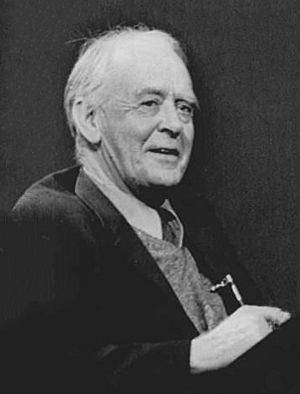John Hicks facts for kids
Quick facts for kids
Sir John Hicks
|
|
|---|---|

Hicks in 1972
|
|
| Born |
John Richard Hicks
8 April 1904 Warwick, England, UK
|
| Died | 20 May 1989 (aged 85) Blockley, England, UK
|
| Institution | Gonville and Caius College, Cambridge London School of Economics University of Manchester Nuffield College, Oxford |
| School or tradition |
Neo-Keynesian economics |
| Alma mater | Balliol College, Oxford |
| Influences | Léon Walras, Friedrich Hayek, Lionel Robbins, Erik Lindahl, John Maynard Keynes |
| Contributions | IS–LM model Capital theory, consumer theory, general equilibrium theory, welfare theory, induced innovation |
| Awards | Nobel Memorial Prize in Economic Sciences (1972) |
| Information at IDEAS / RePEc | |
Sir John Richard Hicks (born April 8, 1904 – died May 20, 1989) was a very important economist from Britain. An economist is someone who studies how people and countries make choices about money, goods, and services. Many people think he was one of the most influential economists of the 1900s.
One of his most famous ideas is the IS–LM model. This model helps explain how the economy works on a large scale, looking at things like national income and interest rates. This is part of what is called macroeconomics. He also made big contributions to consumer theory, which looks at how people decide what to buy. This is part of microeconomics, which studies smaller parts of the economy.
His book Value and Capital (published in 1939) helped improve the idea of general equilibrium theory. This theory tries to show how all parts of an economy fit together and balance out. In 1972, he won the Nobel Memorial Prize in Economic Sciences. He shared the prize for his important work on general equilibrium theory and welfare economics, which looks at how to make people in society better off.
Contents
Early life and education
John Hicks was born in 1904 in a town called Warwick, in England. His father, Edward Hicks, worked as a journalist for a local newspaper.
He went to Clifton College from 1917 to 1922. After that, he studied at Balliol College, Oxford from 1922 to 1926. He was able to go to college because he received scholarships for his skills in mathematics. When he first started at Oxford, he focused on math. But he was also interested in books and history.
In 1923, he switched his studies to a new program at Oxford. This program was called "Philosophy, Politics and Economics." He finished his degree with "second-class honors." He later said he didn't feel like he was an expert in any of the subjects he studied.
Career highlights
Starting in London
From 1926 to 1935, John Hicks taught at the London School of Economics and Political Science. He first worked as a "labour economist." This meant he studied how workers and businesses interacted. He wrote about industrial relations, which are the relationships between employers and employees.
Over time, he started to focus more on the analytical side of economics. This is where his strong math background became very useful again. He was influenced by other economists like Lionel Robbins and Friedrich Hayek. He also worked with people like Nicholas Kaldor. In 1935, he married Ursula Webb, who was also an economist. She later became known as Lady Ursula Hicks.
Moving to Cambridge and Manchester
From 1935 to 1938, Hicks taught at Cambridge University. During this time, he was mainly busy writing his famous book, Value and Capital. This book was based on the ideas he had developed while working in London.
Then, from 1938 to 1946, he became a professor at the University of Manchester. Here, he did important work on welfare economics. This field looks at how economic policies can improve the well-being of society. He also applied his ideas to "social accounting," which is about measuring a country's economic activity.
Returning to Oxford
In 1946, he went back to Oxford University. He held several important positions there. First, he was a research fellow at Nuffield College, Oxford from 1946 to 1952. Then, he became the Drummond Professor of Political Economy from 1952 to 1965. This was a very respected teaching role.
Finally, he was a research fellow at All Souls College, Oxford from 1965 to 1971. Even after he officially retired, he continued to write and contribute to economics from All Souls College.
Later life and legacy
John Hicks was recognized for his great work. In 1964, he was made a knight, so he became "Sir John Hicks." He also became an honorary fellow at Linacre College, Oxford.
In 1972, he received the Nobel Memorial Prize in Economic Sciences. He shared this award with another famous economist, Kenneth Arrow. The next year, in 1973, he gave his Nobel Prize money to the library at the London School of Economics and Political Science.
Sir John Hicks passed away on May 20, 1989. He died at his home in Blockley, a village in the Cotswolds region of England. His ideas and writings continue to be very important for students and economists today.
See also
 In Spanish: John Hicks para niños
In Spanish: John Hicks para niños
- Hicksian demand function
- Hicks optimality
- Hicks-neutral technical change
- List of economists
- Nobel Prize in Economics

